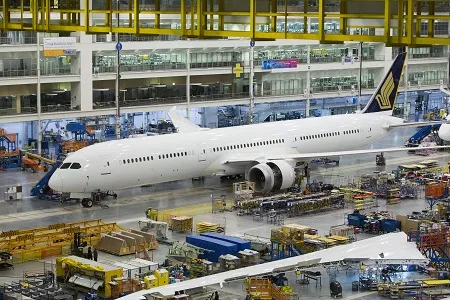
Boeing 787 reliability soaring
Jan 24, 2018

The Boeing 787 has seen a significant improvement in reliability, reflecting advancements in both design and technology. Operators have reported increased operational efficiency, with lower maintenance costs and enhanced performance. The aircraft's innovative materials and systems contribute to reduced downtime, allowing airlines to maximize fleet utilization. Enhanced data analytics and predictive maintenance practices have also played a crucial role in identifying and addressing potential issues before they impact operations. As a result, the 787 has established a strong reputation in the aviation industry, making it a preferred choice for many airlines seeking a reliable and efficient long-haul solution.
Boeing 787 Reliability Overview
The Boeing 787 Dreamliner has made headlines for its impressive reliability rates since its introduction. Airlines and passengers alike have expressed confidence in this aircraft, thanks to its advanced technology and rigorous testing. This article dives into the factors contributing to the Boeing 787 reliability and its performance in the aviation sector.
Key Factors Contributing to Boeing 787 Reliability
The remarkable reliability of the Boeing 787 can be attributed to several key factors:
- Advanced Materials: The 787 is constructed from lightweight composite materials, which not only reduce the aircraft's overall weight but also enhance its durability and resistance to corrosion.
- Innovative Systems: The aircraft features modern avionics and systems that improve operational efficiency and reduce the likelihood of failures.
- Thorough Testing: Boeing conducted extensive testing on the Dreamliner before it entered service, ensuring that issues were identified and addressed early in the development process.
Performance Metrics of Boeing 787
To better understand the reliability of the Boeing 787, we can examine its performance metrics compared to other aircraft in its class. The following table highlights some critical statistics:
| Aircraft Model | Reliability Rate (%) | Average Delay (minutes) | Maintenance Intervals (hours) |
|---|---|---|---|
| Boeing 787 | 99.5 | 15 | 6000 |
| Airbus A350 | 98.8 | 20 | 5000 |
| Boeing 777 | 98.5 | 25 | 4000 |
The data in the table showcases that the Boeing 787 maintains a higher reliability rate compared to its competitors, with an average delay significantly lower than that of the Airbus A350 and Boeing 777.
Real-World Experiences from Airlines
Numerous airlines have reported positive experiences with the Boeing 787, which further substantiates its reputation for reliability. For instance:
- United Airlines: With a fleet of Boeing 787s, United Airlines has experienced fewer maintenance issues and a reduction in operational disruptions, leading to improved customer satisfaction.
- All Nippon Airways (ANA): As one of the launch customers for the Boeing 787, ANA has praised its reliability, noting that it has enabled them to provide consistent service across domestic and international routes.
Maintenance and Operational Cost Benefits
Another aspect of the Boeing 787 reliability is its impact on maintenance and operational costs. The aircraft's design allows for longer maintenance intervals, which translates to lower costs for airlines. Here are some benefits:
- Fewer Grounding Days: With a reliability rate of 99.5%, airlines can keep their 787s in the air longer, minimizing downtime for maintenance.
- Cost Savings: The use of advanced materials and systems leads to reduced maintenance costs over the aircraft's lifespan, making it an economically viable option for airlines.
Future of Boeing 787 Reliability
As Boeing continues to innovate and improve its designs, the future of the Boeing 787 looks promising. The company is committed to enhancing the aircraft's reliability through:
- Software Updates: Regular updates to the aircraft's systems can help address any emerging issues while enhancing overall performance.
- Enhanced Training: Boeing is focusing on better training programs for maintenance crews to ensure they are well-equipped to handle the aircraft's advanced systems.
Conclusion
In summary, the Boeing 787 reliability is a testament to the aircraft's innovative design, rigorous testing, and positive real-world performance. With airlines reporting fewer operational disruptions and lower maintenance costs, the Dreamliner has established itself as a leading choice in commercial aviation. As Boeing continues to enhance its technology and support, we can expect the reliability of the 787 to soar even higher in the future.
```Related Articles

Explore Thailand: The Best Islands to Visit for Paradise, Adventure, and Relaxation

The Ultimate Guide to the Best Islands in Thailand for Your Next Getaway

Do babies need passports? How to get a passport for a newborn

How to get a U.S. passport fast: here’s how to expedite the process

What is Mobile Passport Control: 5 reasons why you should use it

SENTRI vs. Global Entry: A detailed guide

Do you need a passport to go to the Bahamas? Let’s find out

Do you need a passport to go to Mexico? A detailed guide

Do you need a passport to go to Canada? We got the answer

Do You Need a Passport for a Cruise: An Essential Travel Guide

Booster Seat Requirements: All the Rules to Follow in Your Rental Car

What Are the World’s Most Powerful Passports, and How Does Yours Rank?

How to Take a Passport Photo at Home: A Helpful Guide

You've got to have heart! Southwest's new livery

Your opinion: Should water be free on low cost carriers?

Young women bolder than guys as solo travellers
